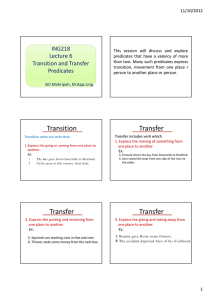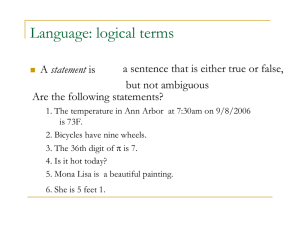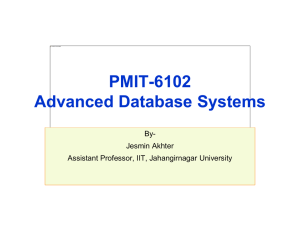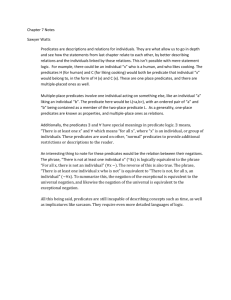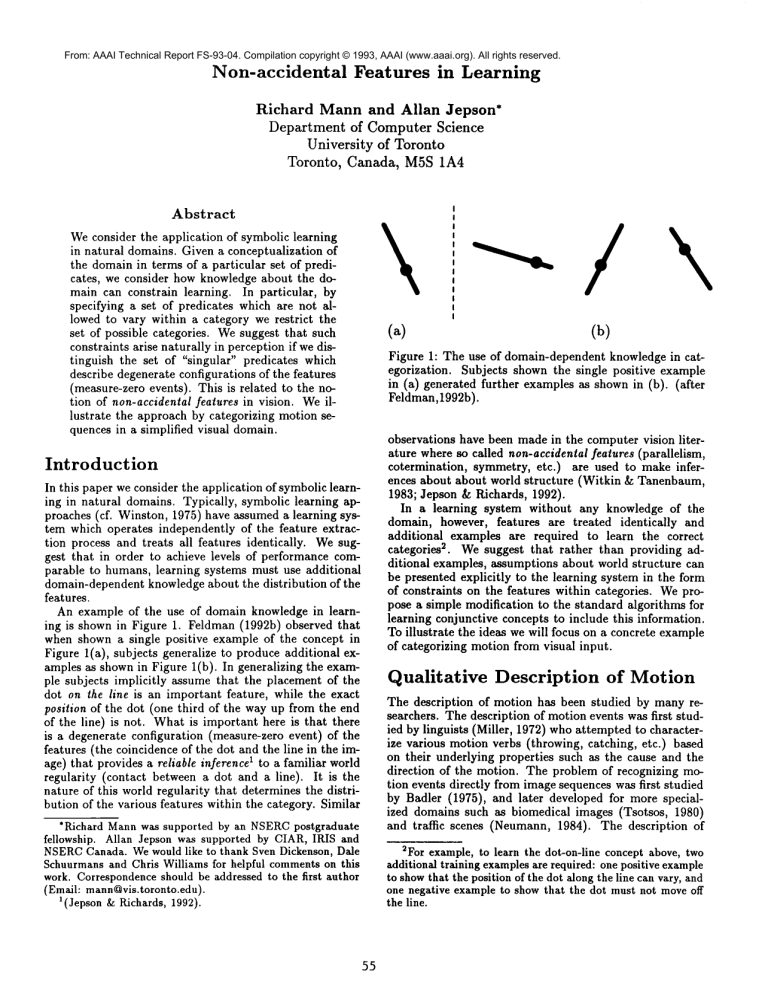
From: AAAI Technical Report FS-93-04. Compilation copyright © 1993, AAAI (www.aaai.org). All rights reserved.
Non-accidental
Features
in Learning
Richard
Mann and Allan
Jepson*
Department
of Computer Science
University
of Toronto
Toronto,
Canada,
MhS 1A4
Abstract
Weconsider the application of symbolic learning
in natural domains. Given a conceptualization of
the domainin terms of a particular set of predicates, we consider how knowledge about the domain can constrain learning. In particular,
by
specifying a set of predicates which are not allowed to vary within a category we restrict the
set of possible categories. Wesuggest that such
constraints arise naturally in perception if we distinguish the set of "singular" predicates which
describe degenerate configurations of the features
(measure-zero events). This is related to the notion of non-accidental features in vision. Weillustrate the approach by categorizing motion sequences in a simplified visual domain.
(a)
(b)
Figure 1: The use of domain-dependent knowledge in categorization. Subjects shown the single positive example
in (a) generated further examples as shown in (b). (after
Feldman,1992b).
Introduction
In this paper we consider the application of symbolic learning in natural domains. Typically, symbolic learning approaches (cf. Winston, 1975) have assumed a learning system which operates independently of the feature extraction process and treats all features identically. Wesuggest that in order to achieve levels of performance comparable to humans, learning systems must use additional
domain-dependent knowledge about the distribution of the
features.
An example of the use of domain knowledge in learning is shown in Figure 1. Feldman (1992b) observed that
when shown a single positive example of the concept in
Figure l(a), subjects generalize to produce additional examples as shownin Figure l(b). In generalizing the example subjects implicitly assume that the placement of the
dot on the line is an important feature, while the exact
position of the dot (one third of the way up from the end
of the line) is not. What is important here is that there
is a degenerate configuration (measure-zero event) of the
features (the coincidence of the dot and the line in the image) that provides a reliable inference 1 to a familiar world
regularity (contact between a dot and a line). It is the
nature of this world regularity that determines the distribution of the various features within the category. Similar
*Richard Mannwas supported by an NSERCpostgraduate
fellowship. Allan Jepson was supported by CIAR, IRIS and
NSERC
Canada. Wewould like to thank Sven Dickenson, Dale
Schuurmansand Chris Williams for helpful commentson this
work. Correspondenceshould be addressed to the first author
(Email: mann~vis.toronto.edu).
l(Jepson &Richards, 1992).
55
observations have been made in the computer vision literature where so called non-accidental features (parallelism,
cotermination, symmetry, etc.) are used to make inferences about about world structure (Witkin & Tanenbaum,
1983; Jepson & Richards, 1992).
In a learning system without any knowledge of the
domain, however, features are treated identically and
additional examples are required to learn the correct
categories 2. Wesuggest that rather than providing additional examples, assumptions about world structure can
be presented explicitly to the learning system in the form
of constraints on the features within categories. Wepropose a simple modification to the standard algorithms for
learning conjunctive concepts to include this information.
To illustrate the ideas we will focus on a concrete example
of categorizing motion from visual input.
Qualitative
Description
of Motion
The description of motion has been studied by many researchers. The description of motion events was first studied by linguists (Miller, 1972) whoattempted to characterize various motion verbs (throwing, catching, etc.) based
on their underlying properties such as the cause and the
direction of the motion. The problem of recognizing motion events directly from image sequences was first studied
by Badler (1975), and later developed for more specialized domains such as biomedical images (Tsotsos, 1980)
and traffic scenes (Neumann, 1984). The description
2For example, to learn the dot-on-line concept above, two
additional training examplesare required:one positive example
to showthat the position of the dot along the line can vary, and
one negative exampleto show that the dot must not moveoff
the line.
motion is also the subject of muchresearch in the area of
qualitative reasoning (Bobrow, 1985). All of these studies
assume a well defined hierarchy of motion events specific
to the domain. In this paper we consider how such natural
categories may be learned from visual input. In particular, we consider how domain knowledge will constrain the
categories formed.
To illustrate the problem consider a simple domain containing a ball and a table. Weuse an interval based representation (McDermott, 1980) consisting of a series of "motion eras" described by a set of predicates (binary valued
features) indicating the motion of the ball as shownin Figure 2. The description is qualitative in the sense that each
assignment of the predicates specifies a "primitive" category that represents a range of possible observations.
T:
X:
L:
R:
Y:
U:
D:
G:
touches table
moves horizontally
movesleft
moves right
movesvertically
moves up
moves down
gravitational motion (ie.,
~)
at 9.8m/s
TXLYG
TXRYG
TXYG
TXYDG
rolling(L)
rolling(R)sitting falling
TXLYUG
proj(LU)
TXRYUG
proj(RU)
TXLYDG
proj(LD)
TXLYDG
proj(RD)
TXLYUG
flying(LU)
TXRYUG TXLYDG TXRYDG
flying(RU) flying(LD) flying(RD)
TXYUG
flyvert(U)
TXYDG
flyvert(D)
TXYUG
bouncing
TXYG
floating
m
TXLYG
flyhoriz(L)
TXRYG
flyhoriz(R)
(b)
Figure 3: The primitive categories of motion eras given
by the consistent assignments of predicates. (a) Observed
cases. (b) Remaining unobserved cases.
accelerate downward
Figure 2: Predicates used to describe motion of ball.
Based on consistency of the predicate assignments (and
assuming the table is horizontal) we can rule out most
combinations, but are still left with 18 possible eras as
shown in Figure 3. Let us consider a world where we observe only eight of the possible motion eras as shown in
Figure 3(a). These observations would arise, for example,
in a domain where the only source of support is from the
table, and where the ball is a "beanbag" which does not
bounce whenit hits the table. Oncegiven a set of relevant
predicates, the task of the machine learning system is to
decide howthe primitive categories should be grouped into
different classes.
Natural
Constraints
on Learning
The problem of grouping the observations into one or more
classes is one of unsupervised learning, or clustering. Following the approach of Michalski & Stepp (1983) we can
cluster the observations into a set of one or more conjunctive concepts where the observed motions are treated as
positive examples and the unobserved cases as negative examples. Wedefine a categorization g = {Cx, C~,..., Cm}
as a set of conjunctive concepts with each Ci E [T, F, .]n
specifying a generalization of one or more of the primitive
categories. A categorization is a covering if each observed
case can be generalized to one or more of the concepts,
and none of the unobserved cases are covered 3. Wetypically choose the most general set of concepts given by the
preference,
3Note that we allow the concepts to cover inconsistent assignments of the predicates as well as the observed cases--we
assumethat in describing the categorization the user specifies
the consistency constraints as well as the covering.
56
Ordering (Parsimony): A partition t71 is preferred over {7 only if each concept in {7 is covered by a single concept in {71 and there are
fewer concepts in {71.
For the example considered here, possible generalizations
of the positive examples are shown in Figure 4. Choosing the most general cover gives the categories {ontable,
projectile, freefall} shownat the top of the figure.
At this point we note that blindly applying the learning algorithm to obtain the maximally general covers does
not form reasonable categories. For example, while it
seems reasonable to group leftward and rightward rolling
in the same category, we may not wish to group sitting and
rolling. That is, because sitting is really a degenerate case
of rolling (in which the horizontal velocity is absent) it
assumedthat a different underlying process is involved and
these events should be categorized differently. To implement this constraint we distinguish the set of "singular"
predicates which describe degenerate configurations of the
feature space (ie., measure-zero events) and stipulate that
the categories must not generalize these predicates,
ConstrMnt (Singular predicates):
A covering {7 is disallowed if it generalizes one or more
predicates which describe degenerate configurations of the feature space.
In our example, the singular predicates correspond to
T, X, Y, G which describe degenerate configurations of
position, horizontal and vertical velocities, and acceleration respectively. Applying the constraint yields a unique
preferred covering with the categories {rolling, sitting,
projectile, falling}, as shownby the boxes in Figure 4. This
corresponds to our intuitive notion of motion categories.
HTXYG
carrying
/
I[pickup
lifting
carry(L)
carry(R)
. x.o
holding
Figure 5: New eras observed in a new context where a
robot hand touches the ball (designated by predicate H).
Note that due to the singular predicate, H, these observations are categorized independently of those in Figure 4.
/
/
/
/
HTXYG J HTXYG
drop
/
/
/
/
/
HT--XYG [ HTXYG
throw
Figure 7: Classification of "events" based on the transition
between motion eras. The values of the predicates before
and after the transition are shown.
~’J
j
,V, y,"V
J
,,, , ,,,
/
a)
/
/
/
/
HYXYIHTXYG I HTXY
throw
b)
/
/
/
H--TXY I HTXYG[ HTXY Figure 8: Segmenting motion sequences. According to Rubin (1986) the motion is usually segmentedat the points
bounce
contact with the table as in (a). (b) showsanother possible
segmentation.
Figure 6: Using information at the interval boundaries (beginning and end points) to disambiguate between the throw
and bounce events. The values of the predicates at the beapproach is to cluster events based on the particular set of
ginning and end of the intervals are shownat the left and
singular predicates relevant to the domain.
right of the eras respectively.
A more difficult question, however, concerns how to define events in the first place. Consider the bouncing ball
shown in Figure 8. According to the set of features prevertical alignment of the bug and the ball, the single catsented
in this paper the sequence would be segmented at
egory drop-bali-on-bug would describe this event. In this
both
the
bounces and the peaks of the path since the disituation the singular predicate bug-under-hand would alrection
of
motion changes in each case. According to exlow us to predict the dropping event. Note that in each of
periments
performed
by Rubin (1986), however, subjects
these examples the system must be given new, sometimes
generally
segment
the
motion only at the bounces as shown
non-obvious features. This process is similar to the idea
in
Figure
8(a).
Rubin
explains this by noting that the
of noticing "suspicious coincidences" in features (Barlow,
bounces
have
a
sudden
change
of direction which implies a
1990) and the idea of detecting "unexplained regularities"
force
impulse,
while
the
peaks
follow a smooth path with
in scientific discovery (Langley et al, 1987).
no implied change in forces.
Describing "events" by changes in motion
As noted by Badler (1975) we consider any change in
motion as an "event". For example, as shown in Figure 7,
the change between the era where the hand contacts the
ball and where the ball is free falling define a dropping or
throwing event. Using the clustering principles described
above, these events, as well as others such as bouncing, hitting, etc., could be categorized. Wedo not develop these
ideas here, but the representation would be similar to that
proposed by Borchardt (1990) where a set of templates
used to describe all possible transitions between different
motion states or eras 4. The main difference, however, is
that rather than merely storing a series of cases (or applying some domain-independent clustering heuristic), our
4Asimilar idea of storing a series of "visual cases" to describe
motionevents (eg., the collision betweendifferent objects) was
proposed by Narayanan (1992)
57
Discussion
In this paper we have proposed a general principle for constraining learning in natural domains based on simple assumptions about the set of predicates we use to conceptualize the domain. As noted by Mitchell (1980), we can
view our singularity constraint on categories as a bias in
learning. Wecan also view this approach as specifying a
very weak form of domain theory to the learning algorithm.
Similar ideas of restricting generalization have been proposed by other authors (cf. Soloway, 1978) but have typically been based on ad hoc rules. Here we attempt to justify our biases based on prior assumptions about the events
in the world (ie., our choice of singular predicates). This
idea is related to the notion of "non-accidental features"
in vision. Witkin & Tanenbaum (1983) noted that nonaccidental image features such as parallelism and coter-
TXYG
projectile]
TXYG
rolling
TXLYG TXRYG [ TXYG
rolling(L) rolling(R)[ sitting
TXYUG
proj(U)
TXLYG
proj(L)
TXRYG
proj(R)
TXYDG
proj(D)
, T-X,oo
proj(LU)proj(aV)proj(LD) proj(RD)falling
I
Figure 4: Generalization of observed motion eras (bottom row) to conjunctive concepts. The X’s mark generalizations
prevented by the constraint discussed in the paper. The boxes show the preferred categories.
Singular Predicates and
Qualitative Probabilities
The singular predicate constraint has a natural interpretation if we view each concept as specifying a qualitative
probability distribution over the domain. A predicate is
singular with respect to a particular domainif it (or its
negation) describes a measure-zero subset of the feature
space which occurs with non-zero probability. The singular predicate constraint simply means that we don’t allow
categories which contain singularities.
As described by Jepson & Richards (1992), we note that
the set of singular predicates is a result of the types of
regularities that exist in the world. For example, the observation of G (acceleration at 9.8 m/s2) is due to the fact
that there is gravity in the world, the observation of Y
(zero vertical velocity) is due to the fact the objects can
be supported by the table, etc. Note that other features,
such as a particular non-zero value of horizontal velocity,
are not singular predicates since there are no corresponding regularities in the world that occur with a non-zero
probability.
An important unanswered question concerns how to determine the set of singular predicates for a particular domain in the first place. While there are in principle an
infinite numberof possible singularities, we can restrict
our search to plausible ones based on some general knowledge about the domain (ie., the types of objects we expect in the world). This view is supported by psychological experiments for the motion domain where Rubin
(1986) demonstrates that there are only a small number
of perceptually distinguishable motion events (eg., starts,
stops, accelerations, etc.) that are used to form categories.
A more general question concerns which of the remaining (non-singular) predicates are relevant to forming categories. While there are no general criteria for determining
relevance of particular features to a class (see Watanabe,
1985 for a discussion) it may be possible to provide some
58
specific principles to guide learning in particular domains.
For example, as described by Pazzani (1990) we may use
assumptions about causality (eg., temporal precedence,
no action at a distance) to rule out irrelevant features in
learning. Evidence for similar principles (eg., object persistence, spatiotemporal continuity, support relations) has
been presented in the developmental psychology literature
(see Spelke, 1988 for a review).
Extending
Learning
In the previous section we showed how domain knowledge
about the predicates could be used to constrain the categories formed. Wenow sketch an approach to learning in
more complex domains by considering several examples.
Extending the context by adding new features
Consider a system which observes a robot hand as well
as the ball and table. Suppose that when the hand does
not contact the ball we observe the same set of eras as
above, but when the hand contacts the ball we observe
the new eras shown in Figure 5. According to the principles described above we would form the new categories
{pickup, lifting, carrying, holding} distinguished by the
presence of the hand. According to the singularity constraint, each new assignment of the singular predicates
(hand contact in this case) defines a new context for categorization. As another example, consider motion eras due
to the two events, throwing and bouncing as shownin Figure 6. In order to differentiate between the two events, the
system must consider the boundaries of the motion eras.
The fact that the throw era starts with hand contact while
the bounce era starts with table contact serve to differentiate the events. Finally, an interesting special case occurs
when a new context yields a single category. For example, imagine a system which observes a dropping event (ie.,
transition from holding to falling) whenever a bug moving
on the table comes directly under the hand holding the
ball. If the system had a singular predicate describing the
mination between line segments provide strong cues for
world structure. Feldman (1992a, 1992b) used a similar
argument to justify the use of such regularities in categorization. A formal analysis of non-accidental features
and perceptual inference is given by Bennett et al (1989)
and Jepson & Richards (1992). The idea of a qualitative
description of probability distributions in terms of singularity structure is similar to that proposed by Bennett et
al (1991).
With respect to the domain of motion sequences, much
remains to be done. As noted in the last example, in order
to classify motion sequences more finely, someform of state
information will be required. While a full representation
of state and temporal constraints (for example, using the
situation calculus described by McCarthy & Hayes, 1969)
may be required in general, a partial representation may
be sufficient.
As noted by Rubin (1986) some new set
features based on the underlying dynamics (forces, mass,
gravity, etc.) may be used. While our approach may be
extended in this direction, it appears that to describe more
complex motion events (eg., throwing, catching, etc.)
will need more abstract features to describe physical relations such as contact, attachment, and support (see Siskind,
1992 for a discussion). Weare currently investigating ways
to extend the learning framework in this way.
References
Badler N (1975), Temporal scene analysis: Conceptual descriptions of object movements, PhDthesis, University
of Toronto.
Barlow H (1990), Conditions for versatile learning, 14elmholtz’s unconscious inference, and the task of perception,
Vision Research, 30:1561-1571.
Bennett B, 14offman D & Prakesh C (1989), Observer mechanics, London: Academic Press.
Bennett B, Hoffman D & Richards W (1991), Reasoning under uncertainty: Lebesgue logic and order logic,
preprint.
Borchardt G C (1990), Transition space, AI Memo1238,
MIT.
BobrowD G (1985), Qualitative reasoning about physical
systems, Cambridge, MA: MIT Press.
Feldman J (1992a), Constructing perceptual categories,
CVPR g2.
chine Intelligence 4, Meltzer B & Michie D (eds.), Edinburgh: Edinburgh University Press.
Michalski R S & Stepp R E (1983), Automated construction of classifications: conceptual clustering versus numerical taxonomy, 1EEE Trans. on Pat. Anal. ~J Mach.
lntell., 5(4):396-410.
Miller G (1972), English verbs of motion: A case study
semantics and lexical memory, In Coding processes and
human memory, Melton & Martin (eds.), Washington:
I4 Winston & Sons.
Mitchell T M (1980), The need for biases in learning
generalizations,
Technical Report CBM-TR-117, New
Brunswick, N J: Rutgers University, Department of Computer Science.
Narayanan H (1992), Imagery, Diagrams, and Visual Reasoning, PhDthesis, Ohio State University.
NeumannB (1984), Natural language description of timevarying scenes, In Advances in natural language processes, Waltz D (ed.), Hillsdale, NJ: Lawrence Erlbaum.
Pazzani MJ (1991), A computational theory of learning
causal relationships, Cognitive Science 15:401-424.
Rubin J (1986), Categories of visual motion, PhDthesis,
MIT, Department of Brain and Cognitive Sciences.
Soloway E M(1978), Learning = Interpretation -I- Generalization: A case study in knowledge-directed learning, COINS-TR-78-13, University of Massachusetts at
Amherst.
Siskind J M(1992), Naive physics, event perception, lexical semantics and language acquisition, PhDthesis, MIT,
Department of Electrical Engineering and Computer Science.
Spelke E S (1988), The origins of physical knowledge,
Thought without language, Weiskrantz L (ed.), Clarendon
Press.
Tsotsos J K, Mylopoulos J, Covey H D & Zucker S W
(1980), A framework for visual motion understanding,
IEEE Trans. on Pat. Anal. 84 Mach. Intell.,
2(6):563573.
Watanabe S (1985), Pattern recognition: human and mechanical, Wiley.
Winston P H (1975), Learning structural descriptions from
examples, in The psychology of computer vision, Winston
P H (ed.), NewYork: McGraw-14ill.
Witkin A & TanenbaumJ M (1983), On the role of structure in vision, In Humanand machine vision, Beck J,
Hope B & Rosenfeld A (eds.),
New York: Academic
Press.
Feldman J (1992b), Perceptual categories and world regularities, PhDthesis, MIT, Department of Brain and Cognitive Sciences.
Jepson A & Richards W (1992), What makes a good feature?, In Spatial vision in humansand robots, Harris L
& Jenkin M (eds.), Cambridge: Cambridge University
Press.
Langley P, Simon H A, Bradshaw G L & Zytkow J M
(1987), Scientific discovery: Computational explorations
of the creative process, Cambridge, MA:MITPress.
McDermott (1982) A temporal logic for reasoning about
processes and plans, Cognitive Science 6:101-155.
McCarthy J & Hayes P J (1969), Somephilosophical problems from the standpoint of artificial intelligence. In Ma-
59

